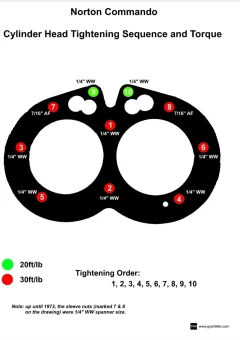- Joined
- Mar 25, 2023
- Messages
- 39
Hello,
I would like your advice and opinions on my '73 850 Commando and the cause of disappearing oil. I estimate I have added in the ballpark of 1 1/2 quarts of oil over 1000 miles of riding. When I top off or change the oil, I typically fill the tank so that the dipstick reads just above the "L" or maybe a quarter or a third between the "L" and the "H" (always biased towards "L"). I am leaking a bit of oil, from where I have not unequivocally identified. But when I park on my cardboard mat, I reckon I am loosing quarter size drops over a day or so, not cups or pints or quarts...I do not notice excessive smoke from the exhaust, not on starting the engine nor riding the bike, although it is hard to say when I am the one riding it. Riding companions have not remarked upon smoky exhaust.
Upon examining the spark plugs, I found that the right plug was fouled; it was black and there was visible oil. The color of the left plug resembled toasted marshmallows, which I think is good. After cleaning up both plugs, I swapped the plug wires and plugs together. After riding a bit, the right plug (originally toasted marshmallow) was now black and oily.
I previously checked compression and it was around 140 psi on both cylinders if I remember correctly. I did this on a cold engine; not sure if that is the right procedure. Fuel consumption has been in the mid forties (U.S. gallons, not imperial). One last bit of information that may be pertinent: on the right side, the bolt next to the spark plug on the cylinder head appears to have oil weeping around it. I noticed this while cleaning the engine and was not able to scrub it away with Dawn and a rag. I am not sure if this has been there since I acquired the bike.
I am sorry if this is too long, but I figure the more detail the better. Is this serious? Valve guides, rings, head gasket? Does the asymmetry of the plugs tip you in one direction? I would not mind a little burning of oil, but the volume seems excessive. Should I start adding it to the tank as for a two stroke?
Thank you in advance.
I would like your advice and opinions on my '73 850 Commando and the cause of disappearing oil. I estimate I have added in the ballpark of 1 1/2 quarts of oil over 1000 miles of riding. When I top off or change the oil, I typically fill the tank so that the dipstick reads just above the "L" or maybe a quarter or a third between the "L" and the "H" (always biased towards "L"). I am leaking a bit of oil, from where I have not unequivocally identified. But when I park on my cardboard mat, I reckon I am loosing quarter size drops over a day or so, not cups or pints or quarts...I do not notice excessive smoke from the exhaust, not on starting the engine nor riding the bike, although it is hard to say when I am the one riding it. Riding companions have not remarked upon smoky exhaust.
Upon examining the spark plugs, I found that the right plug was fouled; it was black and there was visible oil. The color of the left plug resembled toasted marshmallows, which I think is good. After cleaning up both plugs, I swapped the plug wires and plugs together. After riding a bit, the right plug (originally toasted marshmallow) was now black and oily.
I previously checked compression and it was around 140 psi on both cylinders if I remember correctly. I did this on a cold engine; not sure if that is the right procedure. Fuel consumption has been in the mid forties (U.S. gallons, not imperial). One last bit of information that may be pertinent: on the right side, the bolt next to the spark plug on the cylinder head appears to have oil weeping around it. I noticed this while cleaning the engine and was not able to scrub it away with Dawn and a rag. I am not sure if this has been there since I acquired the bike.
I am sorry if this is too long, but I figure the more detail the better. Is this serious? Valve guides, rings, head gasket? Does the asymmetry of the plugs tip you in one direction? I would not mind a little burning of oil, but the volume seems excessive. Should I start adding it to the tank as for a two stroke?
Thank you in advance.

